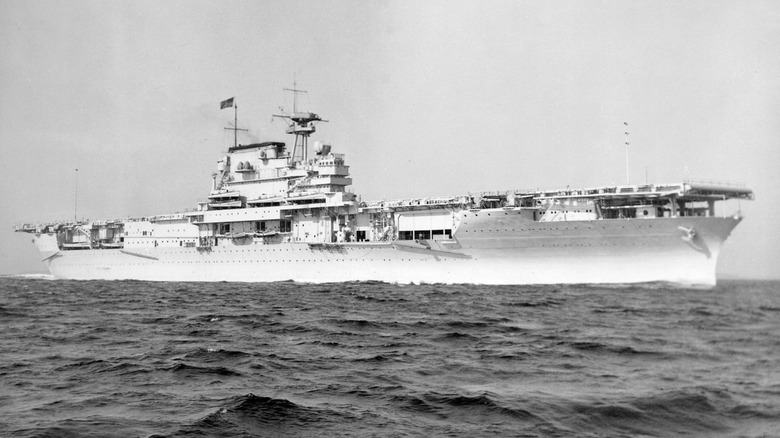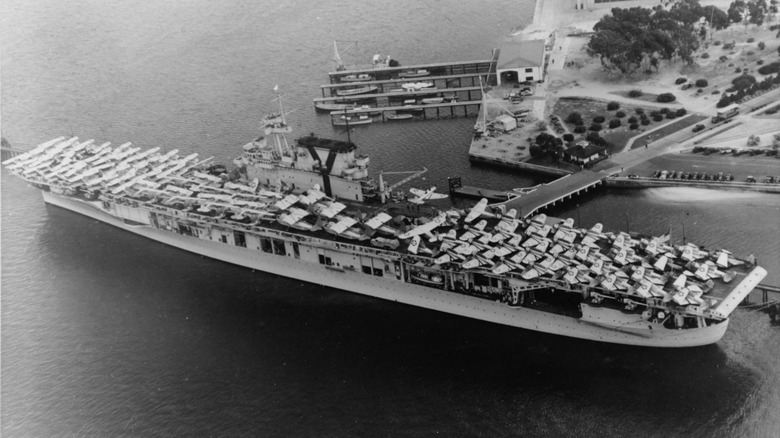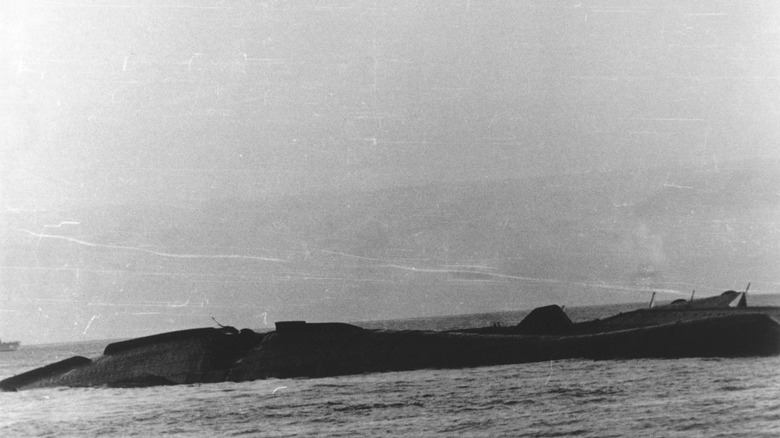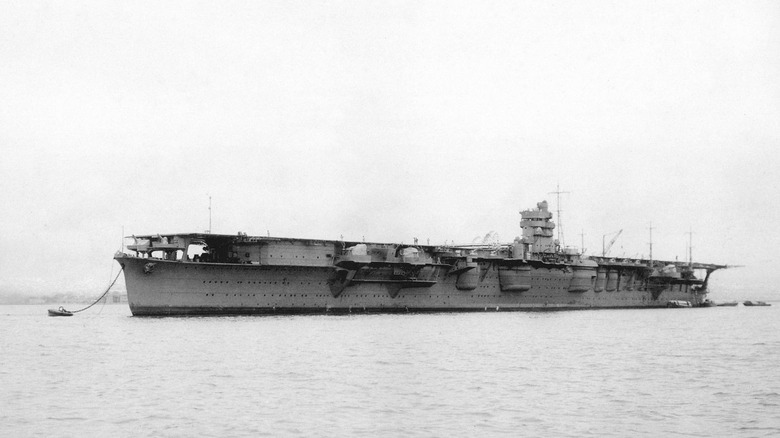What Battle Had The Most Aircraft Carriers Sunk And Which Ships Were They?
On December 7, 1941, the Imperial Japanese Navy launched a devastating surprise attack against the United States naval base at Pearl Harbor. Following the loss of more than 2,400 military and civilian lives was a series of U.S. Navy defeats that seemed to position Japan as a clear victor in the Pacific Theater. Key to the naval conflicts at Pearl Harbor and the subsequent Battle of Wake Island, the Philippines, New Guinea, and Dutch East Indies campaigns were aircraft carriers. The fighters and bombers launched from their decks were capable of causing significant damage. Significant enough, in fact, that when one is lost, it's a critical blow to the full force of the navy fleet.
That's one reason why the Battle of Midway is considered the turning point of the Pacific Theater. Though Japan had a strong footing until June 1942, a key strategic move by the United States shifted the advantage, allowing the U.S. Navy the chance to push west and reclaim territories lost in the early stages of the war. Though many ships were lost during the dozens of engagements in the Pacific waters, it was at Midway that the most aircraft carriers were sunk. Though the United States did suffer losses at Midway, it was the Imperial Navy that limped away with a bruised ego and four carriers lighter.
[Featured image by U.S. Navy via Wikimedia Commons | Cropped and scaled |Public Domain]
Why were aircraft carriers so pivotal to the Pacific Theater
It can be argued that it was aircraft carriers that officially launched the War in the Pacific. After all, the Mitsubishi A6M Zero, which was responsible for much of the damage at Pearl Harbor, couldn't make the flight from Japan's mainland to Hawaii. On the morning of December 7, Akagi, Kaga, Soryu, and Hiryu participated in the launching of more than 300 Zeros on Pearl Harbor. Though that was a sneak attack, carriers served a similar purpose during active battle, proving to be far more useful in engaging the enemy than originally thought prior to the war.
Though aircraft carriers were originally meant to support the bigger guns of battleships, the War in the Pacific proved otherwise. Both Pearl Harbor and the Battle of Midway showed off the real force of a carrier fleet, as the long-range capabilities afforded by fighters and bombers increased the range of attack from about 20 miles to over 200. While battleships used their broadside armament to heavy-blow enemy vessels, a carrier's aerial fleet served two purposes. First, the fighters provided cover for battleships, knocking bombers and kamikaze pilots out of the sky. Then, bombers delivered additional payloads to opposing warships, adding to the damage dealt.
[Featured image by U.S. Navy via Wikimedia Commons | Cropped and scaled |Public Domain]
Carrier losses of the United States Navy
Though the Battle of Midway was a major success in pushing back against Japan's strong naval fleet, the attack wasn't without its sacrifices. Luckily, the only carrier lost during the conflict was the USS Yorktown (CV-5), a vessel that Japan had initially thought was being repaired after sustaining damage at the Battle of the Coral Sea (during which the USS Lexington carrier was lost). However, Yorktown took only two days to repair at Pearl Harbor before being combat-ready.
The USS Yorktown was commissioned in September 1937 and was on patrol in the Atlantic during the Pearl Harbor attack. By the end of December, she had joined the Pacific Fleet, becoming the flagship vessel for Task Force 17. Leading up to her engagement with the Imperial Navy in the Coral Sea, Yorktown served as an escort for Marine deployments to American Samoa. Her presence at the Midway Atoll proved important to the Japanese defeat, as her bombers were responsible for the sinking of the Soryu carrier.
Yorktown and her crew pushed through several damaging attacks, ultimately succumbing to a direct torpedo strike. Though left dead in the water, the carrier only lost around 60 crewmembers before sinking days after the battle. In 2023, the crew aboard the Exploration Vessel Nautilus captured footage of the wreckage of the USS Yorktown.
[Featured image by U.S. Navy via Wikimedia Commons | Cropped and scaled |Public Domain]
Carrier losses of the Imperial Japanese Navy
Solidifying Japan's defeat at the Midway Atoll was its loss of four of its major aircraft carriers. Akagi, Kaga, Hiryu, and Soryu — all of which took part in the bombing of Pearl Harbor — were casualties of the Battle of Midway, a sort of poetic justice for the U.S. Navy. Of the four carriers, Kaga reemerged decades later with the launching of the JS Kaga, the largest warship of Japan's 21st-century Navy. Kaga also happened to be the first Japanese carrier to sustain damage at the onset of the battle. After sinking, Kaga remained an elusive wreckage until the crew of the RV Petrel research vessel located her corpse at a depth of 17,000 feet.
Though initially designed as a battlecruiser, Akagi was later converted into an aircraft carrier. During the Battle of Midway, Akagi sustained only one known direct hit from the USS Enterprise's Bombing Squadron 6, but it was enough to bring down the carrier for good. Like Kaga, the wreckage of Akagi became a success story for RV Petrel in 2019. Unlike Akagi, Hiryu proved a little more difficult to bring down, requiring armament from Enterprise, Hornet, and Yorktown before finally being scuttled on June 5.
As of 2024, the wreckages of Japan's Hiryu and Soryu aircraft carriers have yet to be located, despite the efforts of research teams like RV Petrel.
[Featured image by U.S. Navy via Wikimedia Commons | Cropped and scaled |Public Domain]



